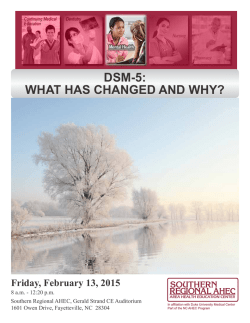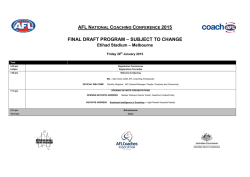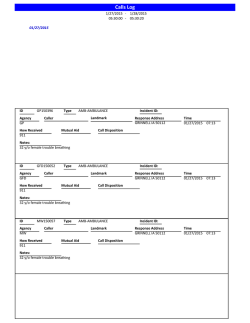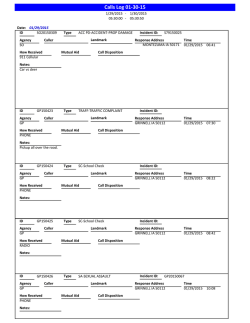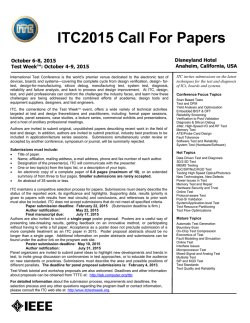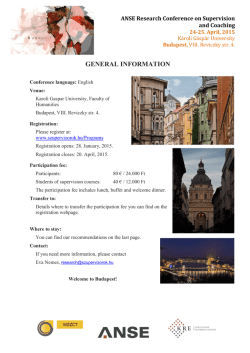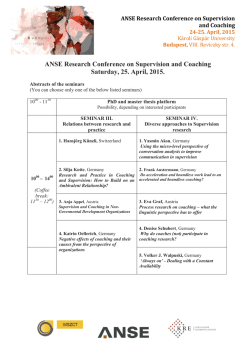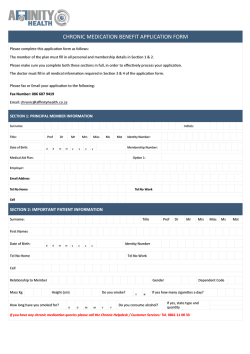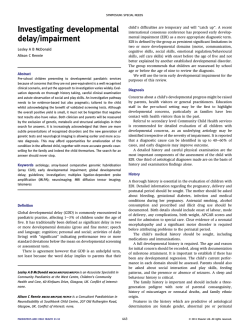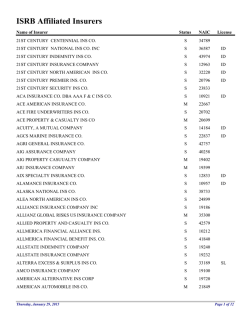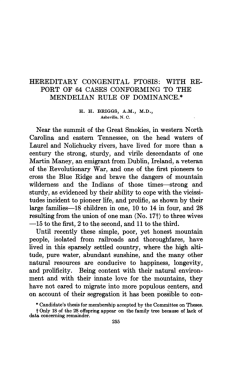
Booklett Teamwork 2015 (PDF, 1.3 MB)
enabling for change Working in Teams What is a team? A team is a small group of persons whose skills complement each other and who commit themselves to a common cause, common performance goals and a common task for which they are mutually accountable. (according to Katzenbach and Smith) Trust in the team as a core element of the performing phase Team cooperation is the backbone of any organization. For those who face complex change more and more frequently, it grows in importance. In the future, a lot will depend on creating and sustaining increasingly diverse lineups: core workforces, freelancers and temporary employed workers, millenials, longtime knowledge carriers and various cultures – perhaps virtually distributed across time zones and continents – under the conditions of work intensification, modern communication media and new working time models. This brochure primarily aims to show you how teams function and what tools can be deployed for team development. We have selected several of our own time-tested tools for you. Using a diagnostic instrument which assesses the 12 aspects of team development according to Francis and Young, we help teams reach the next level of maturity through mutual self-evaluation. The definition of team phases according to Tuckman helps team members and leaders overcome role conflicts and mutually progress from the orientation to the performance phase. In this team process, the role of the leader takes on special significance. This person can give the team effective support by providing its members with various tools. During the entire team process, it is essential to respect differences and utilize them constructively to reach the goals which have been set. The Myers Briggs Type Indicator is a good tool for making developmental potential visible at the team level and the individual level. As trainers and coaches we employ systemic methods. To promote communication, cooperation and trust as well as processoriented thinking and problem-solving strategies, we design, train and facilitate experiential indoor and outdoor learning scenarios. Compact methods of reflection consolidate the results and promote transfer of what has been achieved. When the task at hand is to utilize knowledge and resources to create added value, clarify structures and resolve conflicts or organize a change in management, team development is the key to success. The goal is to develop a highly productive, motivated team. We thank you for your attention. Cordially, your Ralf Messbacher 3 al de vel o y| on vit t| . en 11 pm lea ate Pe rs ati Cre – Aspects of team development according to Francis & Young rop ri Diagnosis: Twelve success factors for team development de r sh ip Offer pp >>> |A Tools 10 . 2. Criticism | 9. e nc a rm rfo Role in the organization | 6. 7. ds | me tho ate pe 4 lim of As consultants, we often initiate team development by employing the 12 aspects of team development formulated by Francis und Young. For purposes of self-evaluation, we use a questionnaire which allows us to identify the team’s top 3 fields of action. In a next step, we introduce target-oriented exercises for each field of action to establish new problem-solving patterns and ground rules. |C l eve a Org 4. 8. |L at niz 3. | Commitment 5. | ion | a Qu s on ti ca lifi 1. >>> 12. | Relationships to other groups Diagnosis Wo rk >>> Leadership means trust and communication – a Bosch leadership team in the „Swabian Alb“ foothills of Germany. Trainer: Jochen Haase 5 >>> Diagnosis >>> Tools >>> Offer Twelve success factors for team development I. Appropriate leadership The group leader has the skill and willingness to work together closely with his team and is willing to take time to develop it. He views leadership of the group as a collective task. Not only the superior but also every other member of the team is given the opportunity to take over managerial functions if his or her special knowledge and skills are in demand. II. Qualifications The members of the team are qualified for their work and are able to contribute their qualifications to the team in such a way that a balanced mixture of skill and personality evolves. III. Commitment The members identify with the goals and objectives of the team. They are willing to invest their energy in team building and in supporting other team members. They feel connected to one another outside of the team as well and know how to stand up for the interests of their group. IV. Climate The team creates a climate which each member feels comfortable with. They interact with each other in an open and direct manner and are willing to take risks. V. Level of performance The team knows what its goals are and considers them to be worthwhile. They require effort but are reachable. The members devote a lot of energy to achieving certain results and they review their past performance critically to modify it wherever necessary. VI. Role in the organization The team is involved in the overall planning and has a clearly defined and purposeful function within the overall organization. 6 VII. Work methods The team has found practical, systematic and effective ways to tackle difficulties together. VIII. Organization Clearly defined roles, good information flow and administrative support are essential pillars of the team. IX. Criticism When discussing their flaws and weaknesses, the members refrain from attacking others personally so as to be able to learn from criticism. X. Personal development The members make a conscious effort to expose themselves to new experiences and they put their entire personality at the service of the team. XI. Creativity Through its interaction, the team has the ability to generate new ideas, promote innovative risks and embrace and implement new ideas which come from within the group or beyond. XII. Relationships to other groups The team has systematically established relationships to other groups and established open personal contacts to ensure optimal cooperation. The teams maintain regular contact and confer on priorities agreed upon among themselves or dictated from higher up. The members have a personal interest in maintaining contact to colleagues from other teams and collaborating with them. 7 >>> Diagnosis >>> Tools >>> Offer Phases of team development The team in the performing phase: we simulate the team’s situation meaningfully by means of short exercises, enabling the 8 members to engage in a mutual learning process in this way. Another possibility for diagnosis is selfevaluation according to the team clock developed by Bruce Tuckman. Through simple self-evaluation using the team clock, teams can quickly assess themselves and determine what needs to be done to reach the next level of maturity. haseF p y t i orm ctiv i ng u d o :o pr : conflict resolution • Mutual enhancement for the situation • Politely expectant • Anxious • Cautious • Search for orientation • Adherence to established ground rules • Honest feedback • Gradual development of team spirit •Clique formation • Struggle for status • Subliminal conflicts • Questioning of leader • Competition, strife • Clear roles and tasks • Frustration • Respect and consideration •Tension t flic ing m r no and sense of purpose n co se p ha • Attempt to get a feel se S p ha t o rm i ng : • Strong feeling of belongingl •Impersonal ion t at Pe rfo rm in •Highly productive • Open and constructive n rie g Team Clock 9 se N orm p ha i ng : >>> Diagnosis >>> Tools >>> Offer Phases of team development Before a new group or team actually becomes productive, it must pass through 4 phases: the orientation phase (forming), the conflict phase (storming), the norming phase (norming) and the productivity phase (performing). The fifth and last phase is the departure phase (leaving). Bruce Tuckman was the originator of this concept. It was described for the first time in 1965. Employees and executive personnel can support the productivity phase considerably during the preceding phases. Phase 1: Orientation phase (forming) At the beginning of any group process, the group’s hour of birth so to speak, there is often a lot of insecurity. The members slowly start to get a feeling for each other. The situation is politely tense and impersonal. The team members expend a lot of energy consciously or unconsciously in clarifying the following questions: •What role do I have in the team; can I fulfill my usual role (boss, clown, outsider, etc.) in this team too? •Who ranks highest and what does distribution of power look like; who do I have to let myself be influenced by and who can I influence? •How much of my personality can I disclose at this stage? •During this phase, leaders can support their team by giving clear instructions and ensuring transparency in regard to the following questions: What are mutual and individual goals? Who has which strengths? Which methods will the team adopt in performing their tasks? What are the basic rules? Phase 2: Conflict phase (storming) After the orientation phase, the focus is put on the struggle for status in the group. Clique formation and competition lead to subliminal conflicts and frustration; in some cases, the formal leader is even called into question. Besides the possibility that an informal leadership position might evolve, the attention of the team members is directed towards finding their own individual roles in the group. Each role can only be occupied once. Storming manifests itself in long speeches, verbal exchanges, etc. Those who make a bid for leadership are the ones who are quick to make suggestions. If the others support these suggestions, the person who made them becomes the opinion leader. There can be no norming and hence no performing either without a relatively intense storming phase being carried out first. Leaders can support their team during this phase through active 10 moderation, mutually developed basic rules and clear messages, for example concerning responsibilities or confirmation of formal roles such as that of the substitute. Phase 3: Norming phase (norming) In this phase, questions and conflicts are clarified which arose during the storming phase. Honest commitment to the ground rules and genuine feedback among team members form the basis for the productivity phase which follows. True team spirit and dedication to a mutual goal should evolve on the basis of clear roles and tasks. Respect and consideration of others are necessary for enabling the team to cope with future challenges with joint effort. One important way in which you, as the leader, can support your team during this phase is by acting as a model for important group standards. Questions you might ask yourself are: How do I deal with violations of rules and evaluate deviations from the group standards (e.g. vis-à-vis outsiders)? Do I address differences constructively? Phase 4: Productivity phase (performing) The team works well together and mutual, desirable goals take the strengths of various team members into consideration. Well-functioning distribution of roles and tasks allow for mutual enhancement. The team is highly productive and is able to weather crises together. Conflicts can be resolved in an open, constructive manner. Mutual experiences in the past have strengthened group cohesiveness and built mutual trust. Energy and creativity are no longer expended for clarification of issues and orientation but directed towards dealing with problems and shaping solutions instead. For leaders, it is now important to prevent regression to lower group levels such as the norming and storming phases. Changes in team lineup generate the risk that new members might reinitiate the struggle for assigning roles and call established group standards into question. Departure (leaving) No team remains unaffected by departure. Team lineups fluctuate, projects and commissions are successfully completed and employees develop new competencies. 11 >>> Diagnosis >>> Tools >>> Offer A team process without contact to the outer world. 3-week outdoor trainer course in the Sisters Wilderness, Oregon USA. 12 Roles in groups For example, during training sessions, we hold a mirror up to the roles adopted by our team members and enable them to replace inflexible role patterns with new role patterns. We support feedback among team members and help the team reach the performing phase or remain there, as the case may be. In the course of team formation, distribution of roles evolves which reflects the distribution of power and influences communication. Typical roles in groups are: leader, follower, outsider, opponent, clown, professor, mediator and – famously – the scapegoat. In the orientation phase (forming), members look for their place in the group. Team members often attempt to adopt roles which made them successful and earned them recognition in other teams in the past. Sometimes people are offered certain roles by other team members. That is, certain expectations are demanded of our behavior which we try to fulfill as well as we can depending on the situation. Thus, human beings play various roles and they often play several roles simultaneously. Everyone ultimately wants to know where he stands with others. Each role is only occupied by one member of each team, however. During the conflict phase (storming) in particular, team members compete for certain roles before the role structure stabilizes in the norming phase (norming). Leaders must always see the group context and must not confuse roles with personality types. Negative roles are also important for a team. To update one’s team in terms of The group dynamics, it is advisable for leaders to give Grey right-hand Leader some thought to group development, eminence man Nagger group phases and roles every once in awhile. Thinker Scapegoat Outsider Mediators Followers 13 >>> Diagnosis >>> Tools >>> Offer Roles within teams Leader Features Leadership The leader is intelligent, motivated, often has a positive mindset and puts forth his ideas with enthusiasm to achieve his goals. For this reason he is popular and has clout. Others listen to him. They do what he says. He thrives on his followers. In contrast to opinion-makers, who put themselves on the throne, there are also so-called champions who do not desire to have a leader status but rather are elevated to the status of leader by others. It is important to win the ringleader over as a partner in order to guide the team. You motivate him by delegating important tasks to him. If he is authoritarian and merely bosses others around, you offer him other modes of behavior such as making suggestions to the team. He could be or become the right hand of the formal team leader. Be careful to avoid public power struggles! As the right-hand man (“the lieutenant”) of the ringleader, he is loyal and avoids critical feedback. He is nimble-witted and quick. As a loyal backer, he ensures that the boss’s orders are carried out. His status relies completely on the leader. He is only solicited via the ringleader. In terms of size, the followers are the largest group and as a rule they fulfill the expectations which are made of them. Followers are flexible in terms of power and are able to subordinate themselves to any leader. They perform their tasks properly, with a certain tendency towards „working by the rules“ not being uncommon. Followers are “service providers who are capable of adapting well“. You can find them wherever informal communication takes place. Followers adopt the opinion of the opinion maker / boss, rarely expressing ideas and wishes of their own. As the leader, it is important to encourage them to express their opinions, welcome the suggestions they make and implement them. This is the “power behind the throne”, e.g. a predecessor or a senior superior who is no longer in the managerial role but who has shaped the team culture. If the formal team leader does not have enough presence, the gray eminence can have a considerable influence. In such cases, the grey eminence leads the team informally. The grey eminence is hard to identify, particularly in the beginning. It is sometimes advisable to let him remain established as the leader. The clown makes jokes, trying to earn recognition and becoming the center of attention in this way. He is not taken seriously, however. He is largely fixed to this role and may not show his real self. Perhaps he feels insecure when he is not in this role and is afraid of becoming an outsider. It is important to give him the opportunity to find acceptance by others without making jokes. Looking for other strengths and drawing his attention to them is the main task of management. The right-handman Followers Grey eminence Clown 14 Outsider Tandem Nagger Features Leadership Outsiders can sometimes be recognized by their behavior or appearance alone. They often have no privileges and their opinion does not count. No notice is taken of them even if they exert great efforts in the team. Sometimes outsiders simply do things their way. They usually feel uncomfortable in their role but the fear of disgracing themselves through their performance outweighs their discomfort. It is important for the leader to encourage him to participate, to integrate him into the group and to converse with him about his own ideas and wishes. The leader must give him the feeling that he belongs. As a tandem (“dyad”), these two team members are “as thick as thieves” They like each other a lot and give mutual support. It is conspicuous that they praise each other’s ideas when they are in a large group. The united force and mutual motivation of a tandem can be utilized to good effect by giving these two individuals mutual tasks. Take care not to set them too much apart from the team as a whole, however. The nagger constantly tests the group and its leader. He often criticizes people and gripes about all kinds of things. Usually, he simply wants to be pampered and seeks recognition. Unfortunately, naggers rarely suggest solutions themselves. Beware: some naggers are never satisfied! The leader should ask him for positive input. Justified criticism should be accepted and unsubstantiated criticism should be dismissed. These team members have a harmonizing effect on other roles in the team. As moderators they mediate and balance out the power relationships; they give feedback and make efforts to clear the air. They maintain a good relationship to everyone and have a large network! As a manager it is sometimes beneficial to request that the mediator engage in active arbitration. His network can be invaluable when it comes to procuring information, etc. The thinker is creative and he often has unconventional ideas. He is capable of speaking logically and argumentatively. He substantiates his views and is able to convince others of his opinions as a result. Weighing matters and discussing them have priority over acting spontaneously. He holds back with his own feelings and remains reserved. Sometimes he does not take practical matters into account to a satisfactory degree. He earns recognition through knowledge rather than through communication. As the leader it is important to make good use of the knowledge of this team member. Attention: sometimes the thinker overtaxes the other team members. In this case, the leader should let him know this. He is the “eternal culprit”. By offering a solution to the question of culpability simply and quickly, he stabilizes the capacity of the group to function well. He often has problems defending himself and lets others give him the blame for all kinds of things. He is usually quite vulnerable and has little contact to other members of the group. As the leader it is important to clarify who actually is responsible for what has been done so as to take the pressure of culpability off of the scapegoat. Showing solidarity with the scapegoat is the first step towards breaking through the game and helping him become integrated into the team. Mediators Thinker Scapegoat 15 >>> Diagnosis >>> Tools >>> Offer The role of the team leader When working with teams, we especially focus on the interaction of the teamleader and the team itself. As coaches we support leaders to take responsibility to manage the many roles and tasks they have to fulfill. For this we often we combine teambuilding and coaching. Regarding to Dick & West (2005) there are different roles and tasks connected with the position of a teamleder: Tasks Abilities Coordinator Clarifies and negotiates goals, organizes division of labor and processes, minds the time, initiates agreements with others Does not exert dominance, must be engaging and persistent Moderator Allows everyone to speak, recognizes and solves communication problems, documents interim results Is able to visualize things, remains neutral, sums things up and stays focused Consultant Clarifies relationship problems between team members, clarifies factual and methodological questions Has a command of conversation techniques (e.g. active listening), is able to show alternatives Manager Solves role conflicts Is able to analyze communication structures and problems, has a basic understanding of mediation techniques Presenter Presents results of team achievements in public Has visualization skills and is an articulate and persuasive speaker Represents team interests vis-a-vis organization and other teams Possesses self-confidence Has the capacity to negotiate resources such as time, money and equipment with the organization Has the ability to be realistic and has a command of negotiation strategies Conflict Representative Negotiation leader 16 s : h n D o istr tp rm flic deleg ibute at an e te, s ta d ra rule sk d set goa enta ls tio u No r m ing ase hie ckn ve m S e t orm has ing p M : e ion c on at se diate, t u nt p g arb i r o un t n, e eForm s a i ng ph y nce, Gi t a :o i m r v v fo eo ri ri pe r c ti ge ls ed f goa l ow nt o e Perf orm e i ng s Give fee ha :p p d ro b g a as s e d ss a ck, a in c Task of the team leader 17 >>> Diagnosis >>> Tools >>> Offer The Myers Briggs Type Indicator consists 18 of 88 questions which we offer in print or digital form The Myers Briggs Type Indicator (MBTI) After 50 years of research, the MBTI is the most common globally used tool for identifying differences in personalities. It has been translated into 30 languages. 3.5 million assessments of this indicator are made annually. Katharine Cook Briggs (1875 – 1968) and her daughter Isabel Briggs Myers (1897–1980) developed the MBTI in its current form on the basis of the work of Carl G. Jung (1875 – 1961). The model focuses on how people receive information and how they make decisions. Differences in the psychological functions preferred, employed and evidenced by individuals indicate certain fundamental differences between human beings, with 16 possible types crystallizing as a result. When it comes to developing effective communication, achieving transparency regarding the strengths of each individual and gaining an understanding of decision-making processes, MBTI is an extraordinarily helpful team development tool. Preferences at a glance: Extraversion Introversion What is your greatest source of energy? What do you direct your attention to? Sensing INtuition How do you like to gather information most? What do you put your trust in? Thinking Feeling Which process do you prefer for evaluating information and making decisions? Judging Perceiving How do you like to interact with the outside world most? 19 >>> Diagnosis >>> Tools >>> Offer The Myers Briggs Type Indicator (MBTI) Whether it is a matter of team development or individual coaching, the MBTI Type Indicator can be used by the group as a whole during team development or by every participant alone at home. We provide the questionnaire containing 88 questions in digital and print form. We report the results to every participant in the form of a so-called best-fit conversation. Participants discover their own personality type with its strengths and developmental potential. They know what impression they make on others in regard to their type and what is important for them in interacting with others. A team development process can be built on the MBTI model completely by working on mutual behavior preferences in everyday work, reflecting on different behavior patterns and exploring solutions for mutual interaction. ST (Sensing/Thinking): Figures, Facts Leadership style: Effective organizer, action-oriented NT (iNtuition/Thinking): Competence Is convinced by: Facts and sober responses to questions SF (Sensing/Feeling): Individual benefit Leadership style: Friendly dialogue partner, need-oriented 20 Leadership style: Conceptual planner, possibility-oriented Is convinced by: Explanations of theoretical background and competence NF (iNtuition/Feeling): Enthusiasm Is convinced by: Elucidation of benefit argumentation Leadership style: Cooperative personality, motivation-oriented Is convinced by: Addressing relationship level Prospect: Our Offer Training of resilience for a team of leaders, Bodensee, Germany. Trainer: Dirk Scharler. 21 >>> Diagnosis >>> Tools >>> Offer Our Offer 1. Desire for change 6. Follow Up Gemeinsame Erfolgsmessung nach mehreren Monaten – Welche Ziele wurden erreicht, was wird noch benötigt? 5. Feedback to the client 2. Clarification of task Feedback discussion between coach and client in the near future Definition of problem and formulation of goal 4. Team development 22 Promotion of Identification and motivation through mutual diagnosis in the team, e.g. on the basis of 12 aspects of team development, selection of main focuses and processing, transfer to work world, trainings for use of tools and agreement on which steps to take next 3. Design creation Selection of methods, setting, alternatives and timing With our mission of “enabling for change”, we tailor our approach to our client. After extensive clarification of our task and the formulation of a goal by our client, we focus on selection of methods and design creation. In doing so, we maintain close contact to our clients. Sometimes it is advisable to conduct interviews before initiating team development, e.g. in conflict situations. During team development, we usually begin with a mutual diagnostic process. Our goal in this phase is to generate a high degree of identification and participation. During the actual team development phase, we work in a process-oriented manner and direct our attention to the declared goals. After the diagnosis has been made – which includes exercises and mutual reflection on the results – and the main focus of activity has been selected, the actual team development process begins. It ends with agreements being made as to which concrete steps should be taken next. After distancing ourselves a bit from the actual team development process, we join our client in reflecting on the team process we experienced. The follow-up phase entails exploring the process further and assessing its success. messbacher Coaching & Consulting stands out in designing valuable change processes for organizations and teams. We integrate coaching and training as customer-tailored support services for our clients. Experts from various fields work hand in hand with us for international clients. Whether we design change processes, strategy workshops or individual trainings and coaching tasks, the first goal is to develop creative, sustainable solutions. Our clients appreciate our refreshing and activating approach. We usually work with existing teams and at various hierarchical levels. 23 >>> Diagnosis >>> Tools >>> Offer Our team of consultants Ralf Messbacher Born in 1972, from 2003 – 2008 change manager in the automotive industry for international projects. Systemic coach and business mediator, EFQM assessor with assessment experience in intercultural contexts (USA, China, Korea, India). Ralf has designed team development processes for various branches since 1999. Core competencies: process support for change, complex moderation (in international settings as well), large group events. Peter Neumann Born in 1970, certified social pedagogue, is a trainer and coach with many years of experience. Peter assists and supports teams in development and change processes. Through his appreciative manner and skill in using a large number of methods, he quickly succeeds in motivating participants, making their resources visible and pooling them. His seminars are characterized by a pleasant atmosphere and a high degree of productivity. In addition to working as a trainer, he has his own systemic consultancy practice. Nora Fitting Born in 1979, degree in business administration (technical college), certified project manager (GPM) and systemic organization consultant. Nora has gathered more than 8 years of experience in project management, consultancy and training, predominantly in the automotive industry. Her main focus of activity: strategy and organization consultancy, management of international/interdisciplinary projects, workshop moderation. 24 Jochen Haase Born in 1968, systemic coach and consultant (IFW, Munich), state-certified mountain and ski guide (IVBV), state examination in mathematics and sports, additional qualification in communication psychology (Schulz von Thun, Hamburg). Jochen has led ten expeditions, among them two eight-thousanders. Main focus of activity: coaching teams and executives in firms and organizations, employee qualification regarding communication, cooperation and management, workshop moderation, team and management development in mountain environments. Dirk Scharler Born in 1968, physiotherapist, trainer and experienced coach. Dirk has worked with managers and top athletes for many years. Apart from working in his own practice, he has worked as a seminar facilitator and instructor Europe-wide for 16 years. Participants of his seminars value his competent and humorous manner of conducting seminars in particular. Core competences: health coaching and stress management (life-work-balance). 25 Bibliography Rolf van Dick, Michael A. West: Teamwork, Teamdiagnose, Teamentwicklung. Hogrefe Verlag GmbH & Co. KG, 2005 Dave Francis, Don Young: Mehr Erfolg im Team. Windmühle, Verlag u. Vertrieb von Medien, 1996 Jon R. Katzenbach, Douglas K. Smith: Teams, der Schlüssel zur Hochleistungsorganisation. Wien, 1993 Isabell Briggs Myers: Einführung in Typen, CPP Ltd, 2001. 26 Raft-building project: spatially separated teams build the same type of raft, with floating elements consisting of balloons! messbacher Coaching & Consulting Schanzenstr. 79 34130 Kassel Germany Tel. u. Fax: +49 (0) 5 61 4 00 98 07 Mobil: +49 (0) 1 60 8 55 56 15 E-Mail: [email protected] www.messbacher.de
© Copyright 2024

